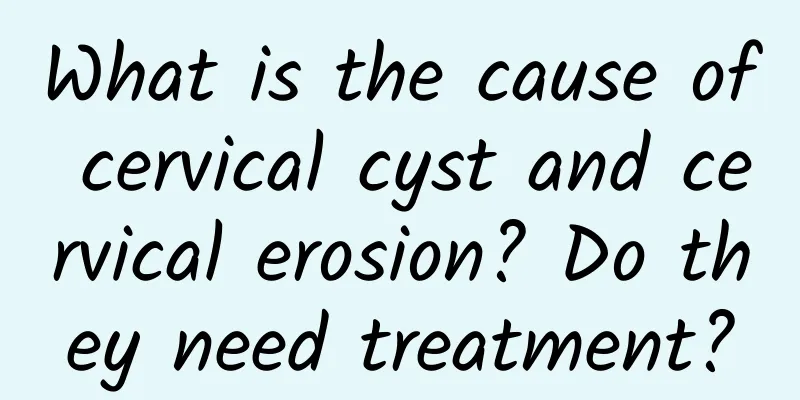What is the cause of cervical cyst and cervical erosion? Do they need treatment?

|
Cervical cysts and cervical erosion are common gynecological problems and require treatment based on specific circumstances. Cervical cysts are usually caused by the accumulation of fluid due to blockage of the cervical glands, forming small cysts, which usually have no obvious symptoms and will not become cancerous. Cervical erosion is the excessive proliferation of the columnar epithelium on the surface of the cervix, resulting in an irregular or red and swollen cervix. In most cases, mild erosion does not require special treatment. However, if you experience discomfort symptoms such as abnormal leucorrhea, contact bleeding or pain, you should seek medical attention in a timely manner to assess whether intervention is needed. During the formation of cervical cysts, the opening of the cervical glands is usually blocked due to the influence of chronic inflammation, and the secretions cannot be discharged smoothly, thus forming cysts. Environmental factors such as poor vaginal hygiene habits, repeated artificial abortions and cervical injuries can also affect the occurrence of cysts. For cervical erosion, physiological factors such as changes in estrogen levels, frequent sexual life, and decreased immunity are the number one driving force. When women find cervical cysts or erosions during physical examinations, regular monitoring is generally recommended. If there is a trend of worsening symptoms, appropriate treatment is required under the doctor's advice, such as physical therapy (cryotherapy, laser, microwave therapy, etc.) or drug therapy (topical anti-inflammatory drugs, etc.). During the formation of cervical cysts, the opening of the cervical glands is usually blocked due to the influence of chronic inflammation, and the secretions cannot be discharged smoothly, thus forming cysts. Environmental factors such as poor vaginal hygiene habits, repeated artificial abortions and cervical injuries can also affect the occurrence of cysts. For cervical erosion, physiological factors such as changes in estrogen levels, frequent sexual life, and decreased immunity are the number one driving force. When women find cervical cysts or erosions during physical examinations, regular monitoring is generally recommended. If there is a trend of worsening symptoms, appropriate treatment is required under the doctor's advice, such as physical therapy (cryotherapy, laser, microwave therapy, etc.) or drug therapy (topical anti-inflammatory drugs, etc.). In order to prevent the problem from getting worse and achieve better health, women are advised to have regular gynecological examinations to detect and deal with cervical-related problems at an early stage. For confirmed cervical cysts or cervical erosions, the doctor's advice can be used to improve lifestyle habits, maintain good vaginal hygiene, and avoid high-risk sexual activities to reduce the possibility of disease progression. If there are any signs of discomfort or worsening symptoms, seek medical attention immediately for professional evaluation and necessary treatment. Maintaining good cervical health is particularly important for women of childbearing age or those who are planning to have children. |
<<: Can I have a gynecological examination if I bleed after sex?
>>: How to treat cervical adhesion after abortion
Recommend
How to treat uterine fibroids How to use medication for uterine fibroids
It is very harmful for women to suffer from uteri...
What is the relationship between irregular menstruation and PCOS?
Polycystic ovary syndrome (PCOS) is a common repr...
What is the best time to have an abortion?
Abortion is the fastest way to terminate an unwan...
Why does pelvic inflammatory disease also cause nausea and abdominal pain
Pelvic inflammatory disease is a common gynecolog...
How much does it cost to treat congenital absence of vagina?
With the increasing incidence of congenital absen...
Introduction: Common methods for treating mild cervical erosion
Mild cervical erosion is a mild gynecological dis...
Experts explain the important postoperative care of adnexitis
Patients with adnexitis will be weak after receiv...
Patients with cervical erosion should understand its symptoms in advance
Cervical erosion is common among married women, a...
How to treat acute cervicitis completely
In the clinical treatment of acute cervicitis, ta...
How many days does it take to detect an ectopic pregnancy?
Generally, ectopic pregnancy can be found about 6...
What should I do if I feel greedy or hungry at night? 6 healthy snacks to increase satiety
I have eaten dinner but I still feel hungry and w...
Does adenomyosis cause excessive vaginal discharge?
After a woman has adenomyosis, her body will unde...
Why do uterine fibroids sometimes not grow? Why do some uterine fibroids not grow?
Why do uterine fibroids sometimes not exist? Why ...
How to avoid excessive free radical production? Nutritionists teach you how to eat to prevent aging!
Wrinkles on the face are something that everyone ...
Experts introduce relevant knowledge about the cost of painless abortion
When choosing a painless abortion, the cost is a ...









